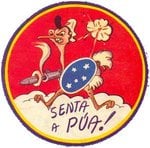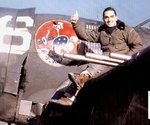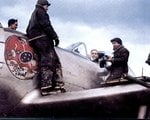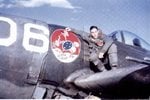Douglas Jr.
Airman 1st Class
Hi folks,
Here a short history about the FAB (Força Aérea Brasileira - Brazilian Air Force) during the Italy Campaign:
The 1º Grupo de Aviação de Caça in Italy, 1944-1945
Formed on 18 December 1943, the 1ºGAVCA had its cadre composed of volunteer FAB (Força Aérea Brasileira) pilots. Its Commanding Officer was Ten.-Cel.-Av. Nero Moura. The Group had 350 men, including 43 pilots, and was sent to Panama for combat training, since the pilots already had flying experience -- one of its pilots, 2º Ten.-Av. Alberto M. Torres, was the pilot of the PBY-5A Catalina that had sunk the U-199.
There, the Group suffered its first casualty -- 2º Ten.-Av. Dante Isidoro Gastaldoni (KIFA).On 11 May 1944, the Group was declared operational and became active in the air cover in the Canal Zone, equiped with the Curtiss P-40.
Following the completion of its initial training, the Group was sent to the USA on 22 June for an operational conversion course on to the Republic P-47D Thunderbolt that was to equip the 1ºGAVCA.
The Group departed to Italy on 19 September 1944, arriving at Livorno on 6 October. There it became part of the 350th Fighter Group USAAF, an unit which had been formed on 1 October 1942 in Britain. Several of its first pilots had served previously with the Royal Air Force or the Royal Canadian Air Force. After the Allied landings in Northern Africa (Operation "Torch"), the 350th FG was transferred to that region and followed the Allied invasion of Italy. Until the arrival of the 1ºGAVCA, the 350th FG was made up of three squadrons: 345th Fighter Squadron ("Devil Hawk Squadron"), 346th FS ("Checker Board Squadron") and 347th FS ("Screaming Red Ass Squadron"). When the 1ºGAVCA - or, rather, the 1st Brazilian Fighter Squadron - 1st BFS - was incorporated to the 350th FG, that unit was subordinated to the 62nd Fighter Wing, XXII Tactical Air Command, 12th Air Force USAAF. The call-signs for each of the Groups component squadrons were: 345th FS, "Lifetime"; 346th FS, "Minefield"; 347th FS, "Midwood"; and 1st BFS, "Jambock"
THE BADGE OF THE 1ºGAVCA
The badge of 1ºGAVCA was designed while the Squadron was travelling to Italy aboard the transport ship UST Colombie by a group of its pilots, Ten.-Av. Rui Moreira Lima, Ten.-Av. José Rebelo Meira de Vasconcelos, Ten.-Av. Lima Mendes and Cap.-Av. Fortunato C. de Oliveira.
Drawn by the latter, it can be described as follows, according to its author:
- The green-yellow surrounding represents Brazil;
- The red field behind the fighting ostrich represents the war skies;
- The bottom field - white clouds - represents the ground to a pilot;
- The blue shield charged with the Southern Cross is the common symbol for the Brazilian Armed Forces;
- The ostrich represents the Brazilian fighter pilot, whose face is inspired in that of Ten.-Av. Lima Mendes, and also the stomach of the veterans of 1ºGAVCA;
- The white cap was part of the FAB uniform at the time and distinguished the Brazilian pilots from the other Allied pilots;
- The gun being hold by the ostrich represents the firepower of the P-47, with its eight .50in machine-guns;
- The motto "Senta a Pua!" is the war cry of 1ºGAVCA;
- The white streak, at the right, ending on a flak burst, was added later, and represents the danger brought by the German anti-aircraft artillery to the pilots (this device appeared only on replacement aircraft).
The use of an ostrich to represent the Brazilian fighter pilots comes from the fact that, during the early Forties, several Brazilian aircrew went to the USA to fly back to Brazil the aircraft then being bought in large numbers by the Brazilian authorities, not only training but also combat aircraft. During their stay in that country, they got acquainted to American food: baked beans, powder eggs and powder milk, among other items. The then Cel.-Av. Geraldo Guia de Aquino dubbed the pilots "ostrichs" and the nickname caught.
The war cry "Senta a Pua!" was a suggestion from Ten.-Av. Rui who had heard it several times from Cap.-Av. Firmino Alves de Araujo while serving at Salvador Air Base; it was used by the latter on his subordinates, inviting them to do their tasks at once and quickly. It became the Brazilian equivalent of the British Tally-Ho and the French "A la Chasse!".
IN ACTION!
The Brazilian pilots initially flew from 31 October 1944 as individual elements of flights of the 350th FG US squadrons, at first in affiliation flights and progressively taking part in more dangerous missions.
Less than two weeks later, on 11 November, the Group started its own operations, flying from its base at Tarquinia, using its call-sign Jambock.
The Group was divided into four flights, Vermelha (Red), Amarela (Yellow), Azul (Blue) and Verde (Green).Each flight had a complement of roughly 12 pilots, these having been flying together since their training spell in Panama. A pilot customarily wore an echarpe in the colours of his flight. The CO of the Group and some officers were not attached to any specific flight.
The Thunderbolt colour scheme
Initially the P-47s were finished in standard US fighter colours, olive-drab (top surfaces) and neutral grey (undersurfaces) (except those aircraft of the commander and operations officer which were finished in natural metal and olive-drab anti-glare panels). The badge of the Group was painted just after the engine cowling, and the aircraft code (flight letter-aircraft number) was in white letters over the cowling.
National insignia was in four positions, this being the US star-and-bar, with the white star replaced by the Brazilian star. Later, replacement aircraft were in natural metal, with olive-drab anti-glare panels, the codes being in black (click here for some pictures of the colour schemes).
THE GROUND CREWS
In every air combat unit, the ground personnel - mechanics, armourers, radio technicians, intelligence officers, supply men, medics and nurses - are those that make every effort so that a few men - the pilots - are able to carry out the missions attributed to them.
The 1ºGAVCA was no exception, having had at its disposal more than 300 men. Commanded by Maj.-Av. Marcilio Gibson Jacques, who showed the utmost ability to organize and communicate with the personnel under his orders, they performed the daily tasks of maintenance with strong determination and dedication to duty - as a result, the Group had a high rate of serviceability.
A group of doctors and nurses were also sent to Italy. Among them was Ten.-Med. Luthero Vargas, son of the then Brazilian president, Getúlio Vargas. Some of the doctors served with the US 12th General Hospital at Livorno, while Cap.-Med. Thomas Girdwood was attached to the Group - he was the first FAB "squadron doctor", although at that time such an appointment did not exist. Six nurses - 2º Tenentes Isaura, Antonina, Judith, Ocimara, Regina e Diva - were attached to the 1ºGAVCA since the training in the U.S.A. until the end of the war.
THE 1ºGAVCA SONG
During the Carnival of 1945, some pilots created the song "Carnival in Venice" after a bombing mission on that town. This song became the Brazilian fighter pilots song after the war.
COMBAT MISSIONS
The Brazilian pilots had been trained in the US for fighter operations -- but the Luftwaffe had by then nearly no airplanes in Italy! Thus the 1ºGAVCA started its fighting career as a fighter-bomber unit, its missions being armed reconnaissance and interdiction, in support of the US 5th Army, to which the Brazilian Expeditionary Force was attached.
On 16 April 1945, the US 5th Army started its offensive along the Pó Valley. On this date, the Group was reduced to 25 pilots, some having been killed and others, having been shot down, becoming POWs. Also, some had been relieved from operations on medical grounds due to combat fatigue. The Yellow flight was thus disbanded, its remaining pilots being distributed among the other flights. Each pilot flew on average two missions a day.
On the 19 April, the German frontline was broken, this having been first signalled to Command HQ by the Group. The Allied forces had to set up a bridgehead across the River Pó, before the German forces crossed it. This was to be done on the 23 April, after a softening up of the German defences by the Air Force on the previous day.
THE 22 APRIL 1945 - DAY OF THE BRAZILIAN FIGHTER ARM
The day dawned cold, overcast and foggy. The three flights took off at 5 minute intervals starting at 8:30 AM, to attack targets in the San Benedetto region, destroying bridges, barges and motorized vehicles.
At 10:00 AM, a flight took off for an armed reconnaissance mission south of Mantua - more than 80 trucks and vehicles were destroyed. Other aircraft attacked fortified German positions, tanks and barges.By the end of the day, the Group had flown 44 individual missions, having destroyed more than a hundred vehicles as well as barges, etc.
Two P-47s were damaged and a third was shot down, its pilot, 2º Ten.-Av. Armando de S. Coelho being taken prisoner. This was the day when more sorties than ever were made by the Group, and is commemorated each year as the Brazilian Fighter Arm Day.
THE RESULTS
The 1ºGAVCA flew a total of 445 missions, 2,550 individual sorties and 5,465 combat flight hours, from 11 November 1944 to 4 May 1945. The XXII Tactical Air Command acknowledged the efficiency of the Group by noting that, between 6 to 29 April 1945, it flew only 5% of the total of missions carried out by all squadrons under its control, but destroyed:
85% of the ammunition depots,
36% of the fuel depots,
28% of the bridges (19% damaged),
15% of motor vehicles (13% damaged) and
10% of horse-drawn vehicles (10% damaged).
The actions of the 1ºGAVCA during the Italian Campaign were even more exhalted on 22 April 1986. On that day the Group received, from the Mr. Ambassador of the USA to Brazil, together with the Secretary for the USAF, the Presidential Unit Citation (Air Force), given by the US Government. It is with pride that we acknowledge that, apart other few USAF units, only the 1ºGAVCA and two Royal Australian Air Force units - Nos. 2 and 13 Squadrons - have received this citation.
"Their deeds will remain alive while men fly. Their victories in the battlefields will be in our hearts while courage and heroism are treasured by men ."
E. Aldridge Jr., Secretary for the USAF, at the bestowing ceremony of the Presidential Unit Citation to the 1ºGAVCA
Hope you enjoy!
Regards,
Douglas.
Here a short history about the FAB (Força Aérea Brasileira - Brazilian Air Force) during the Italy Campaign:
The 1º Grupo de Aviação de Caça in Italy, 1944-1945
Formed on 18 December 1943, the 1ºGAVCA had its cadre composed of volunteer FAB (Força Aérea Brasileira) pilots. Its Commanding Officer was Ten.-Cel.-Av. Nero Moura. The Group had 350 men, including 43 pilots, and was sent to Panama for combat training, since the pilots already had flying experience -- one of its pilots, 2º Ten.-Av. Alberto M. Torres, was the pilot of the PBY-5A Catalina that had sunk the U-199.
There, the Group suffered its first casualty -- 2º Ten.-Av. Dante Isidoro Gastaldoni (KIFA).On 11 May 1944, the Group was declared operational and became active in the air cover in the Canal Zone, equiped with the Curtiss P-40.
Following the completion of its initial training, the Group was sent to the USA on 22 June for an operational conversion course on to the Republic P-47D Thunderbolt that was to equip the 1ºGAVCA.
The Group departed to Italy on 19 September 1944, arriving at Livorno on 6 October. There it became part of the 350th Fighter Group USAAF, an unit which had been formed on 1 October 1942 in Britain. Several of its first pilots had served previously with the Royal Air Force or the Royal Canadian Air Force. After the Allied landings in Northern Africa (Operation "Torch"), the 350th FG was transferred to that region and followed the Allied invasion of Italy. Until the arrival of the 1ºGAVCA, the 350th FG was made up of three squadrons: 345th Fighter Squadron ("Devil Hawk Squadron"), 346th FS ("Checker Board Squadron") and 347th FS ("Screaming Red Ass Squadron"). When the 1ºGAVCA - or, rather, the 1st Brazilian Fighter Squadron - 1st BFS - was incorporated to the 350th FG, that unit was subordinated to the 62nd Fighter Wing, XXII Tactical Air Command, 12th Air Force USAAF. The call-signs for each of the Groups component squadrons were: 345th FS, "Lifetime"; 346th FS, "Minefield"; 347th FS, "Midwood"; and 1st BFS, "Jambock"
THE BADGE OF THE 1ºGAVCA
The badge of 1ºGAVCA was designed while the Squadron was travelling to Italy aboard the transport ship UST Colombie by a group of its pilots, Ten.-Av. Rui Moreira Lima, Ten.-Av. José Rebelo Meira de Vasconcelos, Ten.-Av. Lima Mendes and Cap.-Av. Fortunato C. de Oliveira.
Drawn by the latter, it can be described as follows, according to its author:
- The green-yellow surrounding represents Brazil;
- The red field behind the fighting ostrich represents the war skies;
- The bottom field - white clouds - represents the ground to a pilot;
- The blue shield charged with the Southern Cross is the common symbol for the Brazilian Armed Forces;
- The ostrich represents the Brazilian fighter pilot, whose face is inspired in that of Ten.-Av. Lima Mendes, and also the stomach of the veterans of 1ºGAVCA;
- The white cap was part of the FAB uniform at the time and distinguished the Brazilian pilots from the other Allied pilots;
- The gun being hold by the ostrich represents the firepower of the P-47, with its eight .50in machine-guns;
- The motto "Senta a Pua!" is the war cry of 1ºGAVCA;
- The white streak, at the right, ending on a flak burst, was added later, and represents the danger brought by the German anti-aircraft artillery to the pilots (this device appeared only on replacement aircraft).
The use of an ostrich to represent the Brazilian fighter pilots comes from the fact that, during the early Forties, several Brazilian aircrew went to the USA to fly back to Brazil the aircraft then being bought in large numbers by the Brazilian authorities, not only training but also combat aircraft. During their stay in that country, they got acquainted to American food: baked beans, powder eggs and powder milk, among other items. The then Cel.-Av. Geraldo Guia de Aquino dubbed the pilots "ostrichs" and the nickname caught.
The war cry "Senta a Pua!" was a suggestion from Ten.-Av. Rui who had heard it several times from Cap.-Av. Firmino Alves de Araujo while serving at Salvador Air Base; it was used by the latter on his subordinates, inviting them to do their tasks at once and quickly. It became the Brazilian equivalent of the British Tally-Ho and the French "A la Chasse!".
IN ACTION!
The Brazilian pilots initially flew from 31 October 1944 as individual elements of flights of the 350th FG US squadrons, at first in affiliation flights and progressively taking part in more dangerous missions.
Less than two weeks later, on 11 November, the Group started its own operations, flying from its base at Tarquinia, using its call-sign Jambock.
The Group was divided into four flights, Vermelha (Red), Amarela (Yellow), Azul (Blue) and Verde (Green).Each flight had a complement of roughly 12 pilots, these having been flying together since their training spell in Panama. A pilot customarily wore an echarpe in the colours of his flight. The CO of the Group and some officers were not attached to any specific flight.
The Thunderbolt colour scheme
Initially the P-47s were finished in standard US fighter colours, olive-drab (top surfaces) and neutral grey (undersurfaces) (except those aircraft of the commander and operations officer which were finished in natural metal and olive-drab anti-glare panels). The badge of the Group was painted just after the engine cowling, and the aircraft code (flight letter-aircraft number) was in white letters over the cowling.
National insignia was in four positions, this being the US star-and-bar, with the white star replaced by the Brazilian star. Later, replacement aircraft were in natural metal, with olive-drab anti-glare panels, the codes being in black (click here for some pictures of the colour schemes).
THE GROUND CREWS
In every air combat unit, the ground personnel - mechanics, armourers, radio technicians, intelligence officers, supply men, medics and nurses - are those that make every effort so that a few men - the pilots - are able to carry out the missions attributed to them.
The 1ºGAVCA was no exception, having had at its disposal more than 300 men. Commanded by Maj.-Av. Marcilio Gibson Jacques, who showed the utmost ability to organize and communicate with the personnel under his orders, they performed the daily tasks of maintenance with strong determination and dedication to duty - as a result, the Group had a high rate of serviceability.
A group of doctors and nurses were also sent to Italy. Among them was Ten.-Med. Luthero Vargas, son of the then Brazilian president, Getúlio Vargas. Some of the doctors served with the US 12th General Hospital at Livorno, while Cap.-Med. Thomas Girdwood was attached to the Group - he was the first FAB "squadron doctor", although at that time such an appointment did not exist. Six nurses - 2º Tenentes Isaura, Antonina, Judith, Ocimara, Regina e Diva - were attached to the 1ºGAVCA since the training in the U.S.A. until the end of the war.
THE 1ºGAVCA SONG
During the Carnival of 1945, some pilots created the song "Carnival in Venice" after a bombing mission on that town. This song became the Brazilian fighter pilots song after the war.
COMBAT MISSIONS
The Brazilian pilots had been trained in the US for fighter operations -- but the Luftwaffe had by then nearly no airplanes in Italy! Thus the 1ºGAVCA started its fighting career as a fighter-bomber unit, its missions being armed reconnaissance and interdiction, in support of the US 5th Army, to which the Brazilian Expeditionary Force was attached.
On 16 April 1945, the US 5th Army started its offensive along the Pó Valley. On this date, the Group was reduced to 25 pilots, some having been killed and others, having been shot down, becoming POWs. Also, some had been relieved from operations on medical grounds due to combat fatigue. The Yellow flight was thus disbanded, its remaining pilots being distributed among the other flights. Each pilot flew on average two missions a day.
On the 19 April, the German frontline was broken, this having been first signalled to Command HQ by the Group. The Allied forces had to set up a bridgehead across the River Pó, before the German forces crossed it. This was to be done on the 23 April, after a softening up of the German defences by the Air Force on the previous day.
THE 22 APRIL 1945 - DAY OF THE BRAZILIAN FIGHTER ARM
The day dawned cold, overcast and foggy. The three flights took off at 5 minute intervals starting at 8:30 AM, to attack targets in the San Benedetto region, destroying bridges, barges and motorized vehicles.
At 10:00 AM, a flight took off for an armed reconnaissance mission south of Mantua - more than 80 trucks and vehicles were destroyed. Other aircraft attacked fortified German positions, tanks and barges.By the end of the day, the Group had flown 44 individual missions, having destroyed more than a hundred vehicles as well as barges, etc.
Two P-47s were damaged and a third was shot down, its pilot, 2º Ten.-Av. Armando de S. Coelho being taken prisoner. This was the day when more sorties than ever were made by the Group, and is commemorated each year as the Brazilian Fighter Arm Day.
THE RESULTS
The 1ºGAVCA flew a total of 445 missions, 2,550 individual sorties and 5,465 combat flight hours, from 11 November 1944 to 4 May 1945. The XXII Tactical Air Command acknowledged the efficiency of the Group by noting that, between 6 to 29 April 1945, it flew only 5% of the total of missions carried out by all squadrons under its control, but destroyed:
85% of the ammunition depots,
36% of the fuel depots,
28% of the bridges (19% damaged),
15% of motor vehicles (13% damaged) and
10% of horse-drawn vehicles (10% damaged).
The actions of the 1ºGAVCA during the Italian Campaign were even more exhalted on 22 April 1986. On that day the Group received, from the Mr. Ambassador of the USA to Brazil, together with the Secretary for the USAF, the Presidential Unit Citation (Air Force), given by the US Government. It is with pride that we acknowledge that, apart other few USAF units, only the 1ºGAVCA and two Royal Australian Air Force units - Nos. 2 and 13 Squadrons - have received this citation.
"Their deeds will remain alive while men fly. Their victories in the battlefields will be in our hearts while courage and heroism are treasured by men ."
E. Aldridge Jr., Secretary for the USAF, at the bestowing ceremony of the Presidential Unit Citation to the 1ºGAVCA
Hope you enjoy!
Regards,
Douglas.







